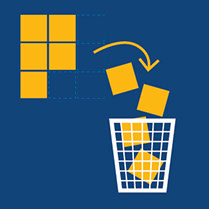










Capture
Store
Archive
Purge
Information Life Cycle.
Innovators at every point of the
Utilize
We believe all phases of your informations life cycle are critical.
Understanding what we do so well starts with understanding the scope of our field. The life cycle of data is often far more complex than just simply "gathering and storing information." Which is why we break it down into five interconnected phases to help refine our clients' needs.
It's called The Information Life Cycle, and it illustrates how getting the most from your data solutions requires a nuanced understanding of the many aspects that influence how information exists for your company.

Phase One: Information Capture
When data enters your enterprise it is the beginning of the information life cycle. This data, once linked with other data in your information systems, will yield meaningful and actionable information for your business.
DTA helps to ensure that your data acquisition processes are adequate to capture all the data that you want and need. We develop and optimize secure processes that capture data across a wide spectrum of input sources and cleanse and transform the data before storing it. Whether the data is created via human data entry points or acquired from outside sources via automated processes, DTA has broad familiarity with the many scenarios for this initial phase of your information's life cycle.


Phase Two: Data Storage
Data must be stored and secured in an optimal manner to minimize storage requirements and allow it to be accessed in fastest possible manner. Our expertise in data compression and security technologies of Oracle, SQL Server and other commonly used databases enable us to help you ensure that your data is secured and its storage is optimized.
DTA possesses unrivaled expertise in this phase of data governance, understanding the breadth of necessities for proper information storage and security. Data integration, movement, transformation, cleansing, change capture, and of course, extract-transform-load (ETL) processes are among the many essential processes DTA performs for you, the client. We develop strong solutions that integrate security with efficient data access to endpoints within your enterprise while balancing the data footprint with the fastest possible access.


Phase Three: Utilization
Once data is securely stored and is available to be accessed, analytic processes can be built to generate actionable information that can be distributed internally for business decisions. Too often the overlooked yet essential point in the life span of data is this reporting, modeling and analytics space. When your data is integrated with new or outside data, very clear inductive reasoning occurs, providing insights and generating information. Insights and information create new data in an iterative data – information cycle.
DTA is a notable expert in understanding this aspect of your enterprise's data, passionate about the modeling components which expand the importance of this phase. This is the phase where your information germinates from the acquired data and creates business intelligence. Our clients leverage our decades of expertise and experience creating valuable reporting and analytics systems for companies across many industries.
This phase also addresses classification of information for authorized application to tasks within the enterprise. Often data usage is complicit in the business model of your enterprise, so understanding the classifications and their applicability to data governance, legality of use, and how data information integrates throughout your enterprise requires an insightful business understanding as well as technical background.


Phase Four: Archiving
Many may regard the phase of information archiving to be a passive point in the chain. In reality, archiving has an entire layer of possible management demands that makes this a surprisingly active phase in the information lifecycle. Data archiving requires a synergy between accessibility and governance. While the data is no longer current for operations it is still valuable for reporting and analytics.
DTA understands the essentials of archiving the precious commodity of data for continued reporting and analysis. While this phase may remove data from active use, it is essential that it remain accessible and continue to yield useful information and insights. As every enterprise has differences in how reporting and analysis occurs within production processes, DTA has honed its talents to bring innovation to this overlooked but important phase.


Phase Five: Data Purge
The end of the life cycle is as critical as stored data can overwhelm the storage space. When data has outlived its usefulness to your enterprise and is no longer required for regulatory purposes, it is vital to purge it from the information systems. The goal is always to maintain optimal access to useful data.
Information is the most valuable asset to your company, and ensuring it remains secure at every stage of its life is important right up until the end of use. DTA maintains its forward-thinking approach to security assurance even at this late stage of data's life. We consult on best practices of data purge, as well as helping your enterprise establish assessment tools to better comprehend when information has completed its life cycle.